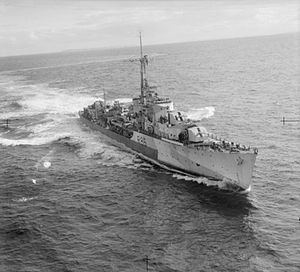Name Cambrian Laid down 14 August 1942 Commissioned 17 July 1944 Construction started 14 August 1942 Length 111 m | Ordered 16 February 1942 Completed 17 July 1944 Recommissioned 1963 Launched 10 December 1943 | |
 | ||
Builder Scotts Shipbuilding and Engineering Company | ||
HMS Cambrian was a C-class destroyer of the Royal Navy, ordered on 16 February 1942. She was originally to be named HMS Spitfire but this was changed to Cambrian before launch to fit her revised class name. She was the seventh British Warship to have had this name. She was adopted by the Civil Community of Colwyn Bay, Wales, as part of the Warship Week programme.
Contents
Wartime service
On commissioning Cambrian was allocated to the 6th Destroyer Flotilla with the Home Fleet and took part in Russian and Atlantic convoys. In 1945 she was allocated for service in the Far East at the close of the Second World War, but joined the Fleet in Trincomalee after VJ-Day.
Post war service
Following the war Cambrian paid off into reserve. Along with other Ca group destroyers, she was selected for modernistion in 1963. Work included a new enclosed bridge and Mark 6M gunnery fire control system, as well as the addition of two triple Squid anti-submarine mortars.
In January 1964 Cambrian saw operational service off the coast of East Africa, as part of the operation to quell the mutiny by the Tanganyika Rifles. The destroyer operated as part of a force, along with the aircraft carrier Centaur, which landed Royal Marines from 45 Commando. Cambrian used her three 4.5-inch guns to provide naval gunfire support.
Decommissioning and disposal
Cambrian was paid off in 1968. She was subsequently sold to Thos W Ward arriving at their breaker's yard at Briton Ferry for scrapping on 3 September 1971.
